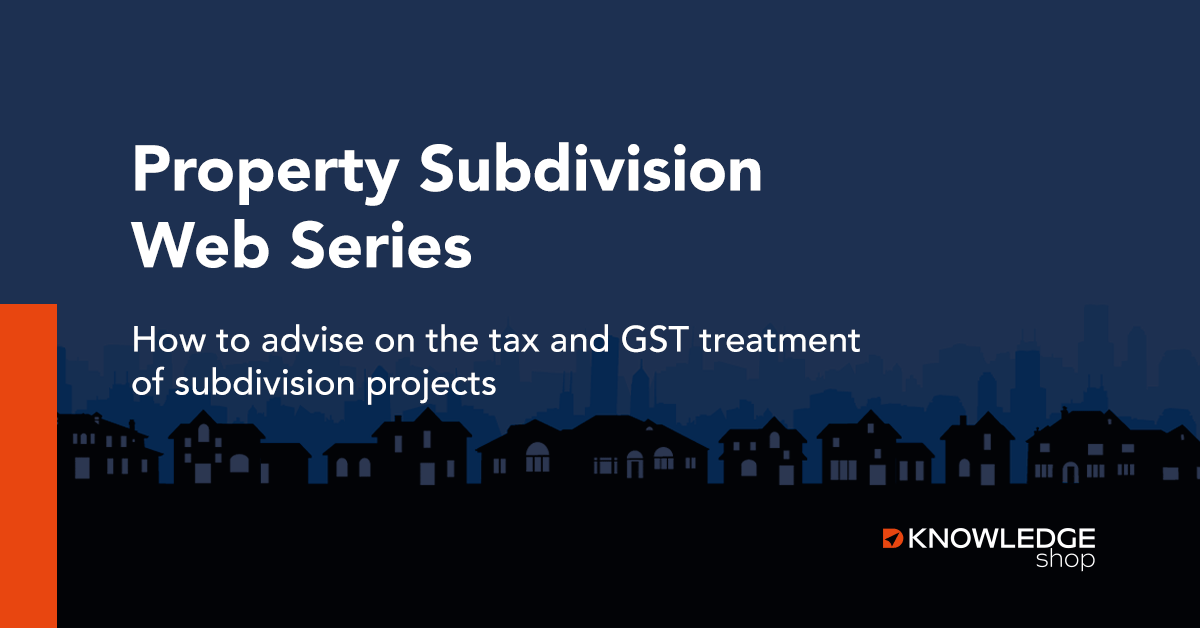July 2023 Round Up - Simplifying the tax residency rules
Finally. Simplification of the individual tax residency rules is getting some traction with the release of a new Treasury consultation paper.
Plus, the new small business energy incentive scheme and what it is likely to mean to your clients. And, what the new ATO guide on small scale property subdivisions says.
Change is a constant for the profession. The Knowledge Shop membership can help you and your team keep ahead of change with an advisers' help desk, workpaper knowledge base, quarterly PD, and more - wherever you are and however you are working. Book in a time for a tour or call the Knowledge Shop team on 1300 378 950.
Inside this month Michael Carruthers (Tax Director), Matthew Tse (Tax Adviser) and Lisa Armstrong (MD) bring you:
Simplifying tax residency of individuals
Treasury has released a consultation paper on the long-awaited proposed reforms to the individual residency rules. If enacted, the proposal would introduce a simple ‘bright line’ test and would ensure that an individual who is physically present in Australia for 183 days or more in any income year will be an Australian tax resident. Individuals who do not meet this primary test will be subject to secondary tests that apply a bit differently depending on their circumstances and would be based on a combination of physical presence in Australia and some limited measurable and objective criteria.
The primary aim of the reforms is to make it much easier to determine whether an individual is a resident of Australia for tax purposes compared with the current position.
The proposed reforms have been a long time coming - the Board of Taxation commenced work in this area back in 2016. The proposed rules already went through an extensive consultation period before being announced in the 2021-22 Budget. Then silence.
However, there is still no guarantee that the rules will be updated. Treasury has indicated that this process will help the Government determine whether to update the rules and whether the changes should be consistent with the Board of Taxation recommendations and the Budget announcement made in May 2021.
Very briefly, the proposed changes involve two primary tests and a series of secondary test that will be applied when an individual is not already treated as a resident under the primary tests.
The first primary test is the simple 183 day ‘bright line’ test where a person who is physically present in Australia for 183 days or more in any income year would be an Australian tax resident.
The second primary test, the ‘government officials test’, effectively replaces the current superannuation test and would operate to ensure government (including federal, state and territory) officials deployed overseas in the service of an Australian government are treated as tax residents throughout their deployment.
The secondary tests are relevant if an individual is not a resident under the primary tests and apply differently depending on whether they were a resident in the previous income year and if so, how long they have been a resident of Australia. A 45 day threshold is used in connection with the secondary tests.
What the small business energy incentive will mean to your clients?
Announced in the May 2023 Federal Budget, Treasury has released the exposure draft legislation to enact the small business energy incentive.
The incentive allows businesses with aggregated annual turnover of less than $50 million to access a bonus deduction equal to 20% of the cost of eligible assets or improvements to existing assets that support electrification or more efficient energy use. The maximum bonus deduction is $20,000 (i.e., up to $100,000 of qualifying expenditure).
To be eligible for the bonus deduction:
- The expenditure must be eligible for a deduction under another provision of the tax law; and
- The asset must be first used or installed ready for use, or the improvement cost incurred, between 1 July 2023 and 30 June 2024.
Some further guidance has been provided on what will qualify as eligible expenditure and this appears to be reasonably broad, if somewhat difficult to quantify. A new depreciating asset is eligible for the bonus deduction if:
- It uses electricity and there is a new reasonably comparable asset that uses a fossil fuel available in the market (e.g., the taxpayer chooses an electric asset over a gas / petrol powered asset); or
- It uses electricity and is more energy efficient than the asset it is replacing or, if it is not a replacement, a new reasonably comparable asset available in the market (e.g., broadly, upgrading to a more energy efficient asset, or picking a more energy efficient new asset); or
- It is an energy storage, demand management or efficiency-improving asset.
Improvements to existing depreciating assets may also be eligible for the bonus deduction if they enable an asset to use electricity instead of fossil fuels, to be more energy efficient, or facilitate energy storage, demand management or monitoring.
There are a range of exclusions from the bonus deduction, including expenditure on assets that can use a fossil fuel, assets which have the sole or predominant purpose of generating electricity, capital works, and motor vehicles.
Financing costs, including interest and borrowing expenses, are also excluded.
New guidance on small scale subdivision projects
The ATO has released helpful, fresh guidance on how to determine the tax treatment of property subdivision activities, both from an income tax perspective and GST perspective. The guides make a useful and practical addition to some of the ATO’s existing and more technical guidance in this area.
When a taxpayer subdivides land into smaller lots it is necessary to determine how the sale of the subdivided lots will be taxed. The three main possibilities are as follows:
- The sale is treated as the mere realisation of a capital asset and taxed under the CGT rules;
- The sale occurs in the ordinary course of a property development business, in which case the land is held as trading stock; or
- The sale occurs in connection with an isolated profit making undertaking, with the net profit or loss being recognised on revenue account.
The ATO guide looks at each of these categories, with reasonably detailed guidance on the key factors that need to be considered in determining the tax treatment of the project such as:
- The type of entity undertaking the subdivision;
- The types of activities the taxpayer is involved in;
- The costs incurred prior to the sale;
- The complexity and steps undertaken;
- The parties and phases involved in the project;
- The taxpayer’s relationship to other parties involved in the subdivision project;
- The taxpayer’s purpose in buying the land; and
- The timing and steps undertaken for the sale.
One of the key points for advisers to remember is that a taxpayer’s purpose might change throughout the ownership period of the land. For example, land initially acquired and held as a capital asset can potentially start being held on revenue account if it is contributed to a profit making project that goes beyond the mere realisation of a capital asset. The ATO guide includes an example on how to undertake tax calculations in situations like this.
While guidance on the GST position is relatively brief, the ATO confirms that where a property project is taxed on revenue account there are likely to be some GST implications, although this will always depend on the situation.
Separately, the ATO has published a guide containing two examples of relatively common scenarios involving the acquisition or subdivision of land, where the ultimate sale is considered to be on capital account.
More information
- Subdividing land
- Tax consequences on sales of small-scale land subdivisions
- Examples of tax consequences on sales of land including small-scale land subdivision
Share this
You May Also Like
These Related Stories

June 2023 Round Up - Skills & Technology "Boosts" in play

Nov 2022 Round Up - The new fixed rate work from home deduction



No Comments Yet
Let us know what you think